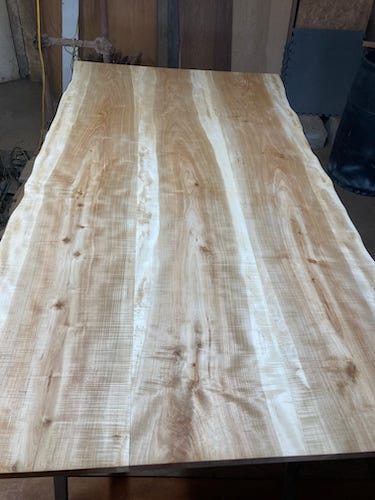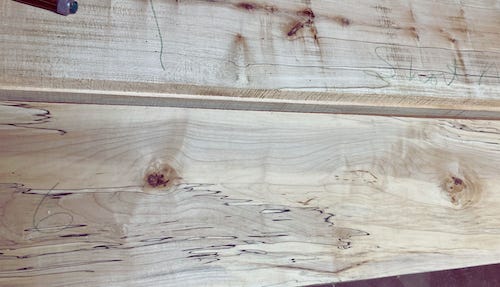Greetings! Today’s newsletter is another old growth post, this one from December 2022. It’s about finite and infinite pursuits. Right now, unpacking and getting settled into a new house feels like a never-ending pursuit. But I know that it’s actually finite, even if the finish line is too far off in the distance to see.
I hope this newsletter finds you well, even if there is chaos surrounding. And if there is, I hope you find the reserves in yourself and in those around you to keep moving forward. ❤️
Projects, process, and the human condition


“Sometimes you eat the bear, sometimes the bear eats you.”
Dad said this to me as we were leaving the shop Sunday evening, except he said it like, “Sometimes you et the bar, sometimes the bar et you.” I’m not sure what the accent is, but the sentiment behind the words is easy enough to understand.
After more than a month of work, we had finally finished assembling the legs, aprons, and frame for my dining table commission and attaching the top. Which had a slight twist. We’d known this and accounted for it by making the frame heavy and rigid to pull the top flat. Except it didn’t work. The twist was so strong that one leg was 1/4” off the ground.
I’ve been sitting here trying to put words to my emotions at that point, but all descriptions feel flat. And if anything, my feelings are closer in resemblance to the table top—as in, decidedly not flat, but twisted and ill contained within the rigid frame of my body.
I recently read Kieran Setiya’s new book, Life Is Hard: How Philosophy Can Help Us Find Our Way. My way doesn’t feel particularly lost, but I enjoy these kinds of books—finding relief from chewing ideas in my mental mandibles.
Setiya, a moral philosopher, shares how philosophers have wrestled with topics core to the human condition: infirmity, grief, loneliness, failure, injustice, absurdity, and hope.
Let’s be clear: I don’t have the scholastic chops to read any primary philosophical sources. I’ve tried, found them unbearably opaque, and set them aside. Now I stick to books written for the masses.
In both this book and his earlier one, Midlife, he talked about the difference between atelic (open-ended) and telic (closed-ended) pursuits. As usual, I approached Josiah, my jovial half, for examples from his own life, and he told me that polishing shoes is telic, but dad jokes are atelic.
Repairing one thing is telic. The number of things to repair is atelic.
And in my own life, building a table is telic. Woodworking is atelic.
On the bear-eating-you days though? That dining table project feels atelic, like this open-ended beast intent on cycling me through failure, absurdity, and hope.
A woodworker once told me that woodworking at any kind of high level is both rewarding and maddening. One must hone perseverance alongside all the other skills.
I think the truly maddening proposition is this: in woodworking, you need to focus on individual projects with a mind toward their completion. However, single-minded focus on the finished product—the destination—is actually a focus on the future, not the present.
Setiya writes:
With telic activities, satisfaction is always in the future or the past. Your ambition is unfulfilled, and then it’s over. Worse, your engagement with what you value is self-destructive. When you pursue a cherished goal, you aim to succeed, and so to end your engagement with something good. It’s as though you’re trying to destroy a source of meaning in your life. Meanwhile, it’s projects like this that expose you to the risk of failure.
So instead focus on the process of woodworking—the journey, right? Find joy in its circuitous routes, accept that no matter how knowledgeable you become, there will ever be new problems to solve, because the number of possible unknowns is inexhaustible. Atelic.
“When you value the process, your relation to the present, and to failure, is quite different,” Setiya continues. “Because they do not aim at terminal states, atelic states are not exhaustible. Your engagement with them does not annihilate them.”
Easier in words than in actions. Easier to love the journey on some days, on some projects. Maybe the work is finding that ease despite the journey’s terrain. Sometimes I wonder if I’m becoming a woodworker or a monk.
That Sunday, the bear-eating Sunday, was a week and a half ago. In the intervening days between then and now, we took the twist out by essentially racking the table top on opposite corners and leaving it for a week. And then we added a long metal bar to act as a truss holding the frame rigid even if the top tries to revert to its previously twisted shape.
The project is complete, at least the wood part. I also have a narrative to finish writing for my clients. It’s about the history of the tree from which the table top was taken and the design and the building process. The rewards and the madness.
For me, writing is an atelic activity.
But for you, these essays are telic endeavors.
Good(ish) Things
Me: I want to include a section in my newsletter of stuff I’m reading that I like. But I don’t want to call it “recommendations” because I hate recommendations.
Josiah: Isn’t this newsletter getting a bit big for its britches?
Me: I’m coming to you for a name idea, not commentary.
J: Martha Stewart has a section in her magazine called “Good Things” and it’s a random list of stuff she likes. Could be books, could be kitchen tools.
Me: I am like the Martha Stewart of woodworking.
J: Hmm.









Thanks for the essay Taliesin. The wisdom of Telic and Atelic activities is a beautiful way to explain your relationship with woodworking. I love the Atelic woodworking experience. I prefer to work with a vision and a very rough plan then let the wood and the project evolve. This allows me to change the project according to the wood and any mistakes or barr8 become a new path. This is why I love my hobby. As their is no end just the process.
I love that Josiah is dropping the Martha Stewart refernences